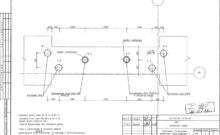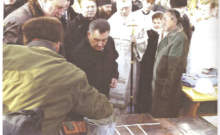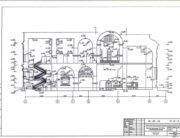In September 1998, in connection with the need to improve the project to strengthen the foundations of the Assumption Cathedral, proposals for the construction of fragments of the Assumption Cathedral and the need for experimental work on the passage of brown-injection root piles of remnants of the ancient cathedral building appeared. The Department of protection of monuments appealed to JSC “Ukrrestavratsiya” with a request to carry out trial drilling of a pile bush on the existing foundations of the cathedral to test the technology of securing the foundations and remnants of strip foundations with bore-injection piles of small diameter.
In 1998, the institute Ukrproektrestavratsiya developed a static test program for piles with a diameter of 200 mm at sites number 1, 2 and C. The program provided for testing these piles at three sites. All the piles were eighteen meters long, passed below the groundwater level and went deep into semi-solid loam by 1.2-1.5 meters. It was planned to make two piles in the casing, and two piles – without casing searches. The tests were carried out on a standard test bench and using a stepped static load with a limit value of 65 tonnes.
The test technology for drilling injecting piles provided for drilling the well under the pipe conductor into contact with the ground filling the well with cement mortar and setting there a condor, drilling the cement stone in the well into the soil with a hole through the screw at the bottom of the foundation to the design block and installing the pipe throughout the foundation and 500 mm below the sole and installation on projects of the depth of the bulk frame and metal pipe ends from the pipe, filling the well with a cement-sand mortar per ton of injector from bottom to top and pressure testing of the well under pressure and topping up the solution to the design level (if necessary
A separate section of the program was devoted to the modeling of the stress-strain state (VAT) of fragments of the base and the “cathedral structures“.
A separate section envisaged an assessment of the bearing capacity of the cathedral structures based on the results of the research and calculations carried out, as well as the selection of reinforcement and the development of recommendations for the design of cathedral supporting structures, the study of building materials of the Assumption Cathedral.
To reinforce the ancient foundations of the Assumption Cathedral, the injection piles of two varieties should be inclined at an angle of 10-15 ° and with a diameter of 200 mm and vertical ones with a diameter of 200 mm. Rostverk arranged the floor of the piles and the remains of the foundation. Before installing the piles, the foundations were cemented by injection of a special solution. The piles passed through the remains of the foundations and were wound into clay for a length of 2-3 m.
XVIII century. Since the cathedral was built gradually, therefore, it is necessary to load the existing walls, the existing pylons (the pylon, by the way, will carry a load of 400 tons) will be transferred below. Therefore, a foundation without a format is needed and this can be achieved only through piles. And dynamic loads must be taken into account, so small diameter piles must be applied, and we chose a method that was widely used abroad, in Italy, where all the sights are supported by just this method. All loads from the cathedral will be transferred to the lower layers of the soil, so as not to burden the ancient foundations. In addition, here we have a cultural layer in which there are more burials, valuable archaeological materials, and if we propose other methods for strengthening existing foundations, for example, expanding their soles, then the cultural layer is left and right along the height of the foundation, where there can be burials, could completely lose its value and as a monument the cathedral could become a “remake”
Careful passing at high speed with diamond coated crowns through existing foundations through piles of small diameter of 20 cm does not create vibrations in the foundation, does not affect the culture layer and transfers the load to the lower layers of the soil.



















